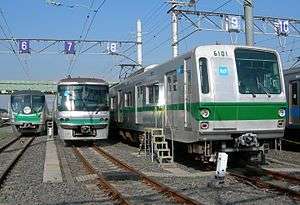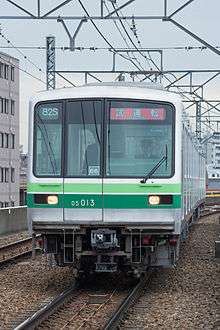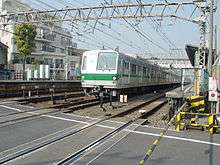Tokyo Metro Chiyoda Line
| Tokyo Metro Chiyoda Line | |
|---|---|
|
| |
 A lineup of Chiyoda Line rolling stock: 16000 series, 06 series, 6000 series | |
| Overview | |
| Native name | 東京メトロ千代田線 |
| Type | Heavy rail rapid transit |
| Locale | Tokyo |
| Termini |
Yoyogi-Uehara Ayase (main line) |
| Stations | 20 |
| Daily ridership | 1,447,730 (2017)[1] |
| Operation | |
| Opened | December 20, 1969 |
| Owner | Tokyo Metro |
| Depot(s) | Ayase, Yoyogi |
| Rolling stock |
Tokyo Metro 6000 series Tokyo Metro 05 series(for Branch Line) Tokyo Metro 16000 series Odakyu 4000 series Odakyu 60000 series MSE JR East 209-1000 series JR East E233-2000 series |
| Technical | |
| Line length | 24.0 km (14.9 mi) (main and branch) |
| Track gauge | 1,067 mm (3 ft 6 in) |
| Electrification | 1,500 V DC overhead catenary |
| Operating speed | 80 km/h (50 mph) |
| Chiyoda Line route map | |||||||||||||||||||||||||||||||||||||||||||||||||||||||||||||||||||||||||||||||||||||||||||||||||||||||||||||||||||||||||||||||||||||||||||||||||||||||||||||||||||||||||||||||||||||||||||||||||||||||||||||||||||||||||||||||||||||||||||||||||||||||||||||||||||||||||||||||||
|---|---|---|---|---|---|---|---|---|---|---|---|---|---|---|---|---|---|---|---|---|---|---|---|---|---|---|---|---|---|---|---|---|---|---|---|---|---|---|---|---|---|---|---|---|---|---|---|---|---|---|---|---|---|---|---|---|---|---|---|---|---|---|---|---|---|---|---|---|---|---|---|---|---|---|---|---|---|---|---|---|---|---|---|---|---|---|---|---|---|---|---|---|---|---|---|---|---|---|---|---|---|---|---|---|---|---|---|---|---|---|---|---|---|---|---|---|---|---|---|---|---|---|---|---|---|---|---|---|---|---|---|---|---|---|---|---|---|---|---|---|---|---|---|---|---|---|---|---|---|---|---|---|---|---|---|---|---|---|---|---|---|---|---|---|---|---|---|---|---|---|---|---|---|---|---|---|---|---|---|---|---|---|---|---|---|---|---|---|---|---|---|---|---|---|---|---|---|---|---|---|---|---|---|---|---|---|---|---|---|---|---|---|---|---|---|---|---|---|---|---|---|---|---|---|---|---|---|---|---|---|---|---|---|---|---|---|---|---|---|---|---|---|---|---|---|---|---|---|---|---|---|---|---|---|---|---|---|---|---|---|---|---|---|---|---|---|---|---|---|---|---|---|---|
| |||||||||||||||||||||||||||||||||||||||||||||||||||||||||||||||||||||||||||||||||||||||||||||||||||||||||||||||||||||||||||||||||||||||||||||||||||||||||||||||||||||||||||||||||||||||||||||||||||||||||||||||||||||||||||||||||||||||||||||||||||||||||||||||||||||||||||||||||
The Tokyo Metro Chiyoda Line (東京メトロ千代田線 Tōkyō Metoro Chiyoda-sen) is a rapid transit line owned and operated by Tokyo Metro in Tokyo, Japan. On average, the line carries 1,447,730 passengers daily (2017), the second highest of the Tokyo Metro network, behind the Tozai Line (1,642,378)[1].
The line was named after the Chiyoda ward, under which it passes. On maps, diagrams and signboards, the line is shown using the color "green" (C), and its stations are given numbers using the letter "C".
Overview
The 21.9 km main line serves the wards of Adachi, Arakawa, Bunkyō, Chiyoda, Minato and Shibuya, and a short stretch of tunnel in Taitō with no station. A 2.1 km branch line between Ayase and Kita-Ayase is located in Adachi. Its official name, rarely used, is Line 9 Chiyoda Line (9号線千代田線 kyūgō sen Chiyoda-sen).
On maps, diagrams and signboards, the line is shown using the color green(C), and its stations are given numbers using the letter "C".
Trains have through running onto other railway lines on both ends. More than half of these are trains to the northeast beyond Ayase onto the East Japan Railway Company (JR East) Joban Line to Toride. The rest run to the southwest beyond Yoyogi-Uehara onto the Odakyu Odawara Line to Hon-Atsugi and to Karakida on the Odakyu Tama Line.
According to the Tokyo Metropolitan Bureau of Transportation, as of June 2009 the Chiyoda Line was the second most crowded subway line in Tokyo, at its peak running at 181% capacity between Machiya and Nishi-Nippori stations.[2]
Basic data
- Distance: 24.0 km (14.91 mi)
- Main line: 21.9 km (13.61 mi)
- Branch line: 2.1 km (1.30 mi)
- Double-tracking: Entire line
- Railway signalling: CS-ATC
Station list
- All stations are located in Tokyo.
- Stopping patterns:
- Commuter Semi Express, Local, Semi Express, and Express trains stop at every station.
- Odakyu Romancecar limited express services stop at stations marked "●" and does not stop at those marked "|".
- The Odakyu Bay Resort limited express service does not stop at stations marked "▲". (It leaves the Chiyoda Line at Kasumigaseki.)
Main line
- ↑ Yoyogi-Uehara is shared by both Odakyu Electric Railway and Tokyo Metro; Odakyu Electric Railway manages the station.
- ↑ Limited express services stop at Yoyogi-Uehara to change drivers and conductors, but passengers may not board or disembark at this station.
- 1 2 Kita-senju and Ayase are shared by both JR East and Tokyo Metro; Tokyo Metro manages the station.
Branch line
Both stations are located in Adachi, Tokyo.
| No. | Station | Japanese | Distance (km) | Transfers | |
|---|---|---|---|---|---|
| Between stations |
From C-01 | ||||
| C19 | Ayase | 綾瀬 | - | 21.9 |
|
| C20 | Kita-ayase | 北綾瀬 | 2.1 | 24.0 | |
Rolling stock
As of 1 April 2016, the following train types are used on the line, all running as ten-car formations unless otherwise indicated.[3]
Tokyo Metro
- 05 series 3-car trains (x4) (since April 2014, used on Kita-Ayase Branch)[4]
- 6000 series (x2) (since 1971)
- 16000 series (x37) (since November 2010)[5]
 05 series 3-car set
05 series 3-car set Tokyo Metro 6000 series on the Odakyu Odawara Line at Higashi-Kitazawa
Tokyo Metro 6000 series on the Odakyu Odawara Line at Higashi-Kitazawa- A Tokyo Metro 16000 series set in February 2012
Odakyu
- 4000 series (since September 2007)[6]
- Odakyu 60000 series MSE (since spring 2008)[7]
- An Odakyu 60000 series MSE Romancecar EMU on a Metro Hakone service, April 2012
JR East
- E233-2000 series (x19) (since summer 2009)
Former rolling stock
- 103-1000 series (x16) (from 1971 until 1986)
- 203 series (x17) (from August 27, 1982 until September 26, 2011)[8]
- 209-1000 series (x2) (from 1999 - 13 October 2018)
- 207-900 series (x1) (from 1986 until December 2009)
- 5000 series 3-car trains (x2) (from 1969 until 2014, used on branch line)
- 6000 series 3-car train (x1) (prototype of the series built in 1968 until 2014, used on branch line)
- 06 series (x1) (from 1993 until January 2015)[9]
- 07 series (x1) (September 2008 - December 2008)
- Odakyu 1000 series (1988-2010)
- Odakyu 9000 series (1972-2006)
- The sole 06 series set in February 2007
 An 07 series set in December 2008
An 07 series set in December 2008
History
The Chiyoda Line was originally proposed in 1962 as a line from Setagaya in Tokyo to Matsudo, Chiba; the initial name was "Line 8". In 1964, the plan was changed slightly so that through service would be offered on the Joban Line north of Tokyo, and the number was changed to "Line 9".
Line 9 was designed to pass through built-up areas in Chiyoda, and also intended to relieve the busy Ginza Line and Hibiya Line, which follow a roughly similar route through central Tokyo.
The first stretch was opened on December 20, 1969 between Kita-Senju and Ōtemachi. The line was almost completed by October 10, 1972 when it reached Yoyogi-Kōen, although the 1 km section to Yoyogi-Uehara was not completed until March 31, 1978.
The branch line to Kita-Ayase was opened on December 20, 1979. This branch primarily serves as a connection to Ayase Depot, but also serves Kita-Ayase station constructed in the area. A three-car shuttle service operates between Ayase and Kita-Ayase.
The Chiyoda Line was one of the lines targeted in the Aum sarin gas attack on 20 March 1995.
On May 15, 2006, women-only cars were introduced on early-morning trains from Toride on the Joban Line to Yoyogi-Uehara.
On March 18, 2008, the Chiyoda Line became the first subway line in Japan with operations by reserved-seating trains when Odakyu Romancecar limited express services began running between Kita-Senju and Hakone-Yumoto (on the Hakone Tozan Line) and Karakida (on the Odakyu Tama Line). Trains also run from/to Shin-Kiba using tracks connecting to the Yurakucho Line.
References
- Shaw, Dennis; Morioka, Hisashi (1992). Tokyo Subways. Hoikusha Publishing.
- 1 2 Tokyo Metro station ridership in 2010 Train Media (sourced from Tokyo Metro) Retrieved July 23, 2018.
- ↑ "Commute". Metropolis: 7. June 12, 2009. Capacity is defined as all passengers having a seat or a strap or door railing to hold on to.
- ↑ 私鉄車両編成表 2015 [Private Railway Rolling Stock Formations - 2015] (in Japanese). Japan: Kotsu Shimbunsha. 23 July 2015. pp. 74–75. ISBN 978-4-330-58415-7.
- ↑ "東京地下鉄千代田線用05系" [Tokyo Metro Chiyoda Line 05 series]. Japan Railfan Magazine. Vol. 54 no. 640. Japan: Koyusha Co., Ltd. August 2014. pp. 67–70.
- ↑ Tokyo Metro (December 21, 2009). "環境配慮型の新型車両16000系 千代田線に導入決定!!" [Environmentally friendly new 16000 series trains to be introduced on Chiyoda Line] (Press release) (in Japanese). Retrieved December 22, 2009.
- ↑ "東京メトロ千代田線への新たな直通運転用車両 新型通勤車両「4000形」 2007年9月デビュー" [New direct drive vehicle to Tokyo Metro Chiyoda Line New model commuter vehicle "4000 form" Debuted in September 2007] (PDF) (in Japanese). February 5, 2007. Archived from the original (PDF) on February 7, 2007.
- ↑ "新型ロマンスカー・MSEの製造を決定 2008年春 東京メトロ線内初の座席指定制特急の乗り入れを開始" [Decided to manufacture the new Romance car · MSE; Initiation of the first seating designation express train in the Tokyo Metro line in the spring of 2008] (PDF) (in Japanese). September 20, 2006. Archived from the original (PDF) on February 18, 2007.
- ↑ 203系が営業運転から離脱 [203 series withdrawn from revenue service]. Japan Railfan Magazine Online (in Japanese). Japan: Koyusha Co., Ltd. 28 September 2011. Retrieved 28 September 2011.
- ↑ 東京地下鉄06系、新木場へ [Tokyo Metro 06 series moved to Shinkiba]. RM News (in Japanese). Japan: Neko Publishing Co., Ltd. 13 August 2015. Retrieved 28 September 2015.
External links
| Wikimedia Commons has media related to Tokyo Metro Chiyoda Line. |